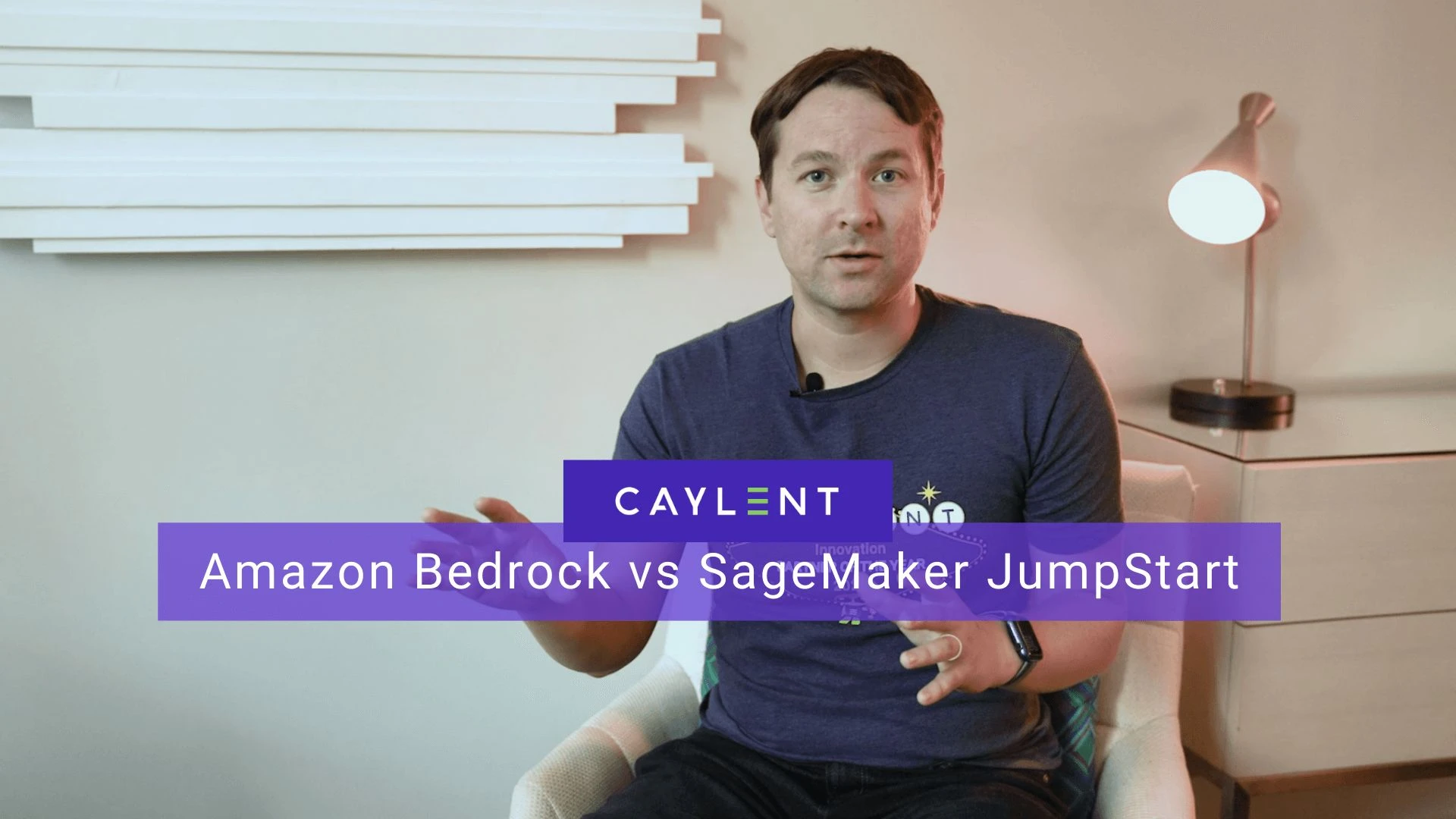
Improving Financial Insights with Amazon QuickSight at a Fortune 500 Network Hardware Company
Learn how an enterprise network hardware company gained granular financial insights and improved business operations with a cloud-based reporting solution.
Learn about the differences in how Amazon Bedrock and SageMaker JumpStart help you approach foundation model training for GenerativeAI Use cases on AWS.

Foundation models have revolutionized the field of generative AI, offering unprecedented capabilities in natural language processing, image generation, and multi-modal tasks. These large-scale, pre-trained models serve as the backbone for numerous AI applications, enabling developers to create sophisticated solutions with minimal effort.
Some major use cases and benefits of foundation models include:
Many development teams turn to AWS for foundation models and generative AI solutions due to the platform's scalability, reliability, and extensive ecosystem of AI/ML services. AWS offers a range of options to suit various skill levels and project requirements, from fully managed services to customizable solutions.
In this blog post, we'll explore two popular AWS offerings for working with foundation models: Amazon Bedrock and SageMaker JumpStart. We'll compare their features, use cases, and deployment efforts to help you make an informed decision on which solution best fits your needs.
AWS offers a few different approaches to running foundation models that can help you create Generative AI solutions.
Beginning at the lowest level but highest DevOps tax is EC2. With EC2, you have access to a wide variety of instance types and capabilities, including things like Inf2 Instances, but you’re also stuck managing the minutiae of the instances.
Most companies prefer to have their developers leverage an orchestration layer like Amazon SageMaker, which removes much of the undifferentiated heavy lifting in ML workloads. SageMaker still requires a developer to select the underlying instances, but they no longer have to maintain them at a basic level. The DevOps tax is lower.
Finally, there’s a new entry to the AI inference service ecosystem - Amazon Bedrock. Bedrock provides a simple InvokeModel API that allows developers to access foundation models using familiar SDKs and HTTP APIs. With Amazon Bedrock, there’s zero DevOps tax and it’s trivial to use.H2 - Amazon Sagemaker JumpStart overview
You can trade DevOps tax for managed computing with Amazon SageMaker, leveraging SageMaker JumpStart, a model hub that provides access to foundation models. SageMaker JumpStart allows you to provision any model, including foundation models like Falcon-40b, Llama 2 or any of the models available on Hugging Face, and it facilitates their deployment onto SageMaker compute instances. SageMaker will manage the underlying compute and provide an HTTP endpoint that you can invoke from your code. It’s also possible to fine-tune the models within SageMaker and add examples relevant for specific industries.
If you’d rather not worry about the underlying compute then look no further than Amazon Bedrock. Bedrock provides a simple API to invoke a foundation model and it is metered on the number of input and output tokens instead of underlying compute. Each model in Bedrock has a different cost, enabling you to optimize the throughput and utilization of these services in diverse ways. We like to think of it as serverless foundation model inference.
While both Amazon Bedrock and SageMaker JumpStart provide access to foundation models, they differ in several key aspects. Understanding these differences can help you choose the right solution for your specific needs.
Amazon Bedrock is ideal for rapid prototyping and quick integration of AI capabilities into applications. It excels in scenarios where minimal infrastructure management is desired, making it perfect for teams looking to experiment with various models.
On the other hand, SageMaker JumpStart is best suited for projects requiring fine-tuning or customization of models. It caters to teams with ML expertise who need more control over the model deployment process. SageMaker JumpStart is particularly advantageous for long-running, resource-intensive ML workloads where optimizing performance and cost is crucial.
The choice between the two often depends on the project's complexity, the team's expertise, and the level of customization required.
In terms of customizability, Amazon Bedrock offers limited options as its models are pre-trained and ready to use out of the box. While this approach ensures ease of use and quick deployment, it also means that fine-tuning capabilities are more restricted. Users can adjust some parameters, but deep modifications to the model architecture or training process are not possible.
Conversely, SageMaker JumpStart provides extensive customization options. It allows for fine-tuning of models for specific use cases, giving users more control over model parameters and training processes. This flexibility is particularly useful for teams working on domain-specific applications or those requiring models tailored to unique datasets. However, this increased customizability also requires more expertise and time investment from the user.
Amazon Bedrock offers a curated selection of high-quality foundation models that are pre-trained and optimized for specific tasks. While new models are added regularly, the selection is more limited compared to SageMaker JumpStart. This curation ensures that the available models are of high quality and well-suited for general use cases.
SageMaker JumpStart provides access to a wider range of models, including those from popular repositories like Hugging Face. It offers more variety in terms of model architectures and sizes, catering to a broader spectrum of use cases. Additionally, SageMaker JumpStart allows users to import and deploy custom models, providing even greater flexibility for teams with specific model requirements or those working with proprietary architectures.
When it comes to deployment effort, Amazon Bedrock shines with its minimal requirements. Users don't need to manage the underlying infrastructure, and integration is achieved through a simple API-based approach. This simplicity makes Bedrock an excellent choice for teams looking to quickly incorporate AI capabilities into their applications without diving deep into the complexities of model deployment.
SageMaker JumpStart, while more complex, offers greater flexibility in deployment options. It requires more setup and configuration, as users need to select and manage compute instances. This increased complexity comes with the benefit of fine-grained control over the deployment process, allowing teams to optimize for performance, cost, or specific architectural requirements.
The trade-off between ease of use and deployment flexibility is a key factor to consider when choosing between these two services.
When ranking each solution on ease of use, Bedrock stands atop, SageMaker positions itself in the middle, and EC2 remains reliable but cumbersome. The way customers take advantage of each solution will depend on the entities, the access patterns, and the use cases involved. Different customers may use varying mixes of some or all of these services. That AWS provides this flexibility is one of the tremendous advantages of working with a larger cloud provider.
We hope this provides you with a quick overview of Amazon SageMaker and Bedrock and how they can fit into your AI initiatives on AWS.
Are you exploring ways to take advantage of Analytical or Generative AI in your organization? Partnered with AWS, Caylent's data engineers have been implementing AI solutions extensively and are also helping businesses develop AI strategies that will generate real ROI. For some examples, take a look at our Generative AI offerings.


Randall Hunt, Chief Technology Officer at Caylent, is a technology leader, investor, and hands-on-keyboard coder based in Los Angeles, CA. Previously, Randall led software and developer relations teams at Facebook, SpaceX, AWS, MongoDB, and NASA. Randall spends most of his time listening to customers, building demos, writing blog posts, and mentoring junior engineers. Python and C++ are his favorite programming languages, but he begrudgingly admits that Javascript rules the world. Outside of work, Randall loves to read science fiction, advise startups, travel, and ski.
View Randall's articles
Learn how an enterprise network hardware company gained granular financial insights and improved business operations with a cloud-based reporting solution.

Discover how we helped a global conveyor belt manufacturer build a real-time IoT data platform for Conveyor Belt Cleaners using Amazon Kinesis.

Explore how organizations can move beyond traditional testing to build robust, continuous evaluation systems that make LLMs more trustworthy and production-ready.